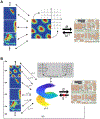Grid coding, spatial representation, and navigation: Should we assume an isomorphism?
- PMID: 31742364
- PMCID: PMC7409510
- DOI: 10.1002/hipo.23175
Grid coding, spatial representation, and navigation: Should we assume an isomorphism?
Abstract
Grid cells provide a compelling example of a link between cellular activity and an abstract and difficult to define concept like space. Accordingly, a representational perspective on grid coding argues that neural grid coding underlies a fundamentally spatial metric. Recently, some theoretical proposals have suggested extending such a framework to nonspatial cognition as well, such as category learning. Here, we provide a critique of the frequently employed assumption of an isomorphism between patterns of neural activity (e.g., grid cells), mental representation, and behavior (e.g., navigation). Specifically, we question the strict isomorphism between these three levels and suggest that human spatial navigation is perhaps best characterized by a wide variety of both metric and nonmetric strategies. We offer an alternative perspective on how grid coding might relate to human spatial navigation, arguing that grid coding is part of a much larger conglomeration of neural activity patterns that dynamically tune to accomplish specific behavioral outputs.
Keywords: entorhinal cortex; grid cells; heuristics; human behavior; spatial navigation.
© 2019 Wiley Periodicals, Inc.
Figures

Similar articles
-
The entorhinal cognitive map is attracted to goals.Science. 2019 Mar 29;363(6434):1443-1447. doi: 10.1126/science.aav4837. Science. 2019. PMID: 30923221
-
Effect of reward on electrophysiological signatures of grid cell population activity in human spatial navigation.Sci Rep. 2021 Dec 8;11(1):23577. doi: 10.1038/s41598-021-03124-y. Sci Rep. 2021. PMID: 34880356 Free PMC article.
-
Environmental Barriers Disrupt Grid-like Representations in Humans during Navigation.Curr Biol. 2019 Aug 19;29(16):2718-2722.e3. doi: 10.1016/j.cub.2019.06.072. Epub 2019 Aug 1. Curr Biol. 2019. PMID: 31378608 Free PMC article.
-
The grid code for ordered experience.Nat Rev Neurosci. 2021 Oct;22(10):637-649. doi: 10.1038/s41583-021-00499-9. Epub 2021 Aug 27. Nat Rev Neurosci. 2021. PMID: 34453151 Free PMC article. Review.
-
Are grid cells used for navigation? On local metrics, subjective spaces, and black holes.Neuron. 2023 Jun 21;111(12):1858-1875. doi: 10.1016/j.neuron.2023.03.027. Epub 2023 Apr 11. Neuron. 2023. PMID: 37044087 Review.
Cited by
-
Episodic representation: A mental models account.Front Psychol. 2022 Jul 22;13:899371. doi: 10.3389/fpsyg.2022.899371. eCollection 2022. Front Psychol. 2022. PMID: 35936308 Free PMC article.
-
Spatial memory deficits in Alzheimer's disease and their connection to cognitive maps' formation by place cells and grid cells.Front Behav Neurosci. 2023 Jan 12;16:1082158. doi: 10.3389/fnbeh.2022.1082158. eCollection 2022. Front Behav Neurosci. 2023. PMID: 36710956 Free PMC article. Review.
-
Regional variation in neurovascular coupling and why we still lack a Rosetta Stone.Philos Trans R Soc Lond B Biol Sci. 2021 Jan 4;376(1815):20190634. doi: 10.1098/rstb.2019.0634. Epub 2020 Nov 16. Philos Trans R Soc Lond B Biol Sci. 2021. PMID: 33190605 Free PMC article.
-
Precision, binding, and the hippocampus: Precisely what are we talking about?Neuropsychologia. 2020 Feb 17;138:107341. doi: 10.1016/j.neuropsychologia.2020.107341. Epub 2020 Jan 13. Neuropsychologia. 2020. PMID: 31945386 Free PMC article.
-
Striatal and hippocampal contributions to flexible navigation in rats and humans.Brain Neurosci Adv. 2020 Dec 21;4:2398212820979772. doi: 10.1177/2398212820979772. eCollection 2020 Jan-Dec. Brain Neurosci Adv. 2020. PMID: 33426302 Free PMC article. Review.
References
Publication types
MeSH terms
Grants and funding
LinkOut - more resources
Full Text Sources

